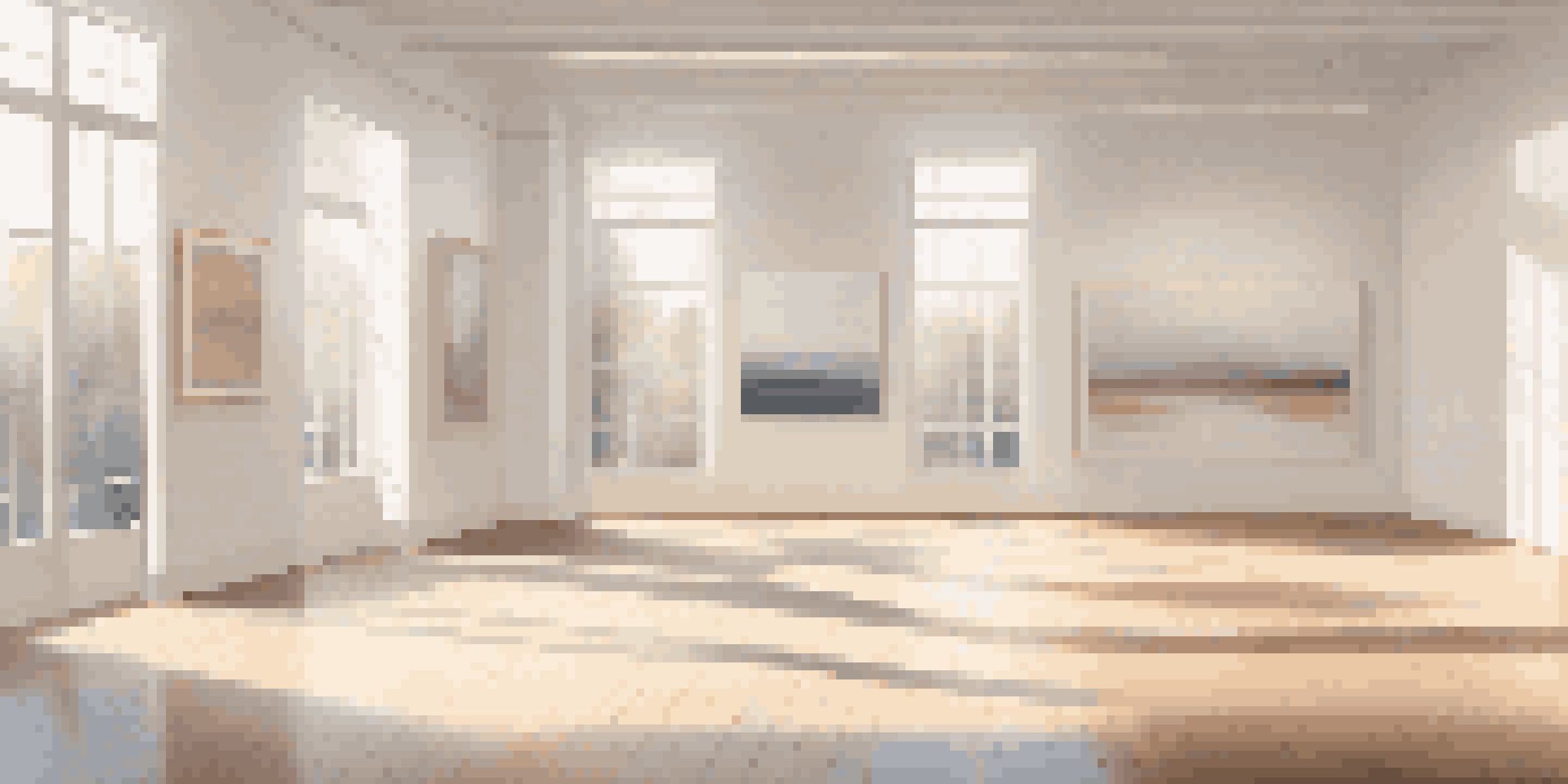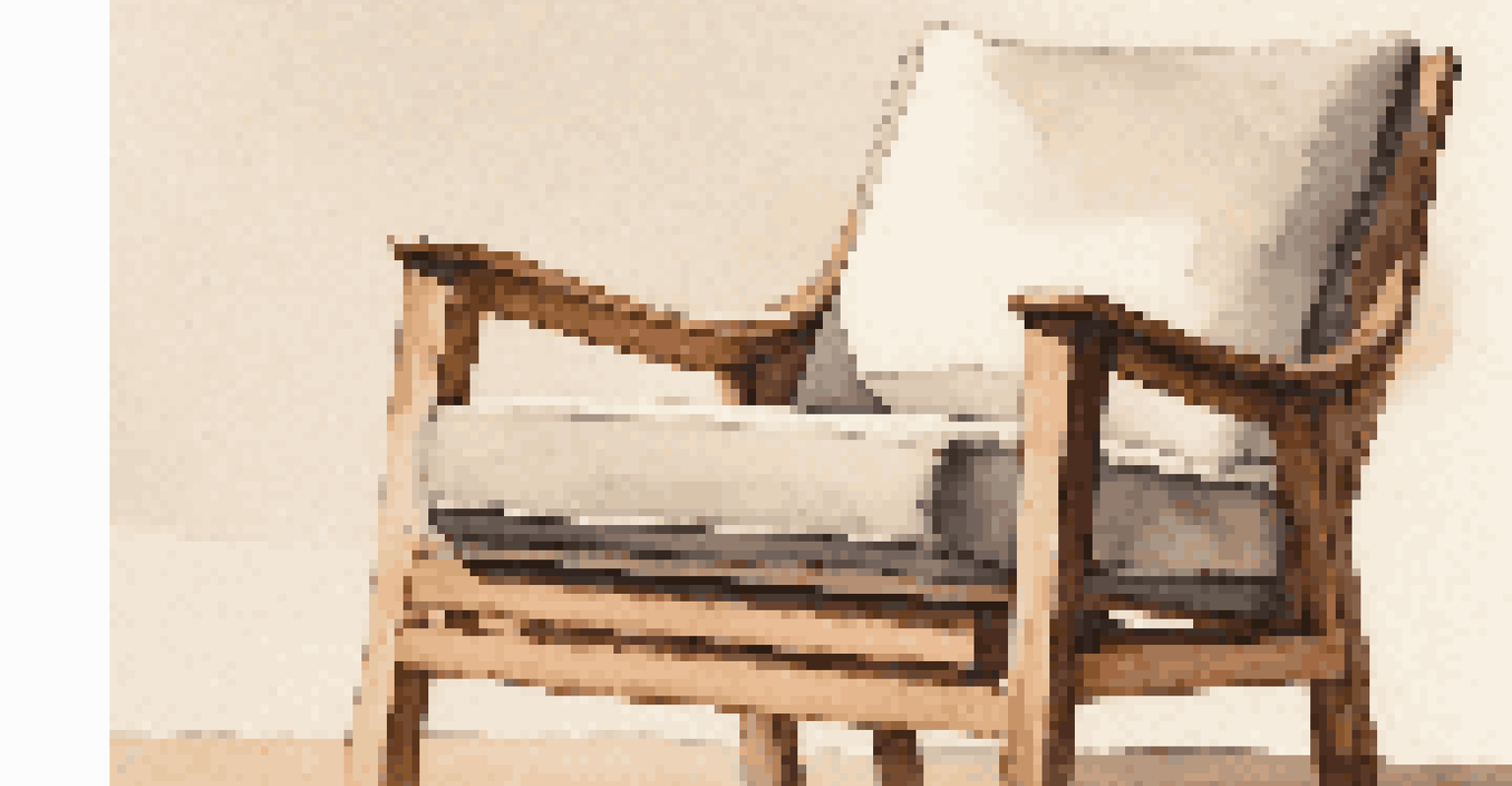The Future of Minimalism in Art: Trends to Watch

The Rise of Digital Minimalism in Art
In today's digital age, artists are increasingly adopting minimalism as a way to express complex ideas through simplicity. Digital platforms allow for innovative interpretations of minimalist concepts, where less truly becomes more. For instance, artists are using fewer elements to create striking visuals that resonate deeply with viewers, showcasing how minimalism can thrive in a tech-driven world.
Simplicity is the ultimate sophistication.
Moreover, the accessibility of digital tools enables a broader range of artists to engage with minimalist practices. This democratization of art means that minimalist pieces can be created and shared more easily than ever, allowing for a diverse array of voices and perspectives. As a result, we’re seeing digital galleries pop up, showcasing minimalist works that challenge traditional notions of art.
Ultimately, the future of digital minimalism may also influence how we interact with art in physical spaces. Imagine walking into a gallery where each piece is carefully curated to create a serene environment. This trend is likely to draw more people toward minimalist art, as it provides a contemplative escape from our often chaotic lives.
Sustainability and Eco-Conscious Minimalism
As the world grapples with environmental issues, many artists are turning to eco-conscious practices within the framework of minimalism. This trend emphasizes the use of sustainable materials and methods, creating art that not only looks good but also does good. For example, some artists are repurposing found objects, turning waste into stunning minimalist sculptures that tell a story of renewal.

This approach not only highlights the beauty of simplicity but also fosters a deeper connection between the artwork and the viewer. People are increasingly drawn to pieces that reflect shared values, such as sustainability and responsibility. By embracing minimalism in this way, artists can provoke thought and inspire action regarding environmental issues.
Digital Minimalism Thrives Online
Artists are leveraging digital platforms to explore and share minimalist art, making it more accessible and diverse.
Looking ahead, we can expect eco-conscious minimalism to gain even more traction. As audiences become more aware of their consumption habits, art that champions sustainability will likely resonate on a deeper emotional level, leading to a shift in how we perceive and appreciate minimalist works.
Cultural Influences on Minimalist Art Trends
Minimalism is not just an aesthetic choice; it's also shaped by cultural contexts and histories. As artists from diverse backgrounds contribute to the minimalist movement, we see fresh perspectives that challenge conventional definitions of minimalism. For instance, Eastern philosophies often emphasize simplicity and balance, which can lead to unique interpretations in minimalist artworks.
The more I read, the more I acquire, the more certain I am that I know nothing.
This blending of cultural influences is enriching the minimalist landscape, creating a tapestry of styles that reflect the global nature of today’s art scene. Artists are now incorporating symbols and themes from their cultural heritage, adding layers of meaning to their minimalist works. This diversity invites viewers to engage with the art on a personal level, fostering a sense of connection.
In the future, we can expect cultural influences to play a pivotal role in shaping minimalist trends. As globalization continues to blur boundaries, the art world will likely become a vibrant melting pot of ideas that promote understanding and appreciation of different cultures through the lens of minimalism.
Technology's Impact on Minimalist Art Creation
The rapid advancement of technology is reshaping how artists create minimalist works. With tools like virtual reality and augmented reality, artists can experiment with space and form in ways previously unimaginable. This opens up exciting possibilities for minimalist art, where the interplay between physical and digital realms creates immersive experiences that engage viewers more deeply.
Moreover, technology allows artists to reach wider audiences through online platforms, making minimalist art more accessible than ever. This democratization of art means that emerging artists can showcase their work without the traditional barriers of galleries and exhibitions. As a result, we’re witnessing a surge in innovative minimalist designs that challenge our perceptions of art.
Eco-Conscious Practices in Art
Many artists are embracing sustainability within minimalism, using eco-friendly materials to create impactful artworks.
Looking forward, technology will continue to play a crucial role in the evolution of minimalist art. As artists embrace new mediums and platforms, the future of minimalism will likely be characterized by boundary-pushing creativity that invites audiences to explore and interact with art like never before.
The Intersection of Minimalism and Functionality
In recent years, there has been a growing trend where minimalism intersects with functionality. This movement highlights the idea that art can serve practical purposes while still being aesthetically pleasing. For example, many minimalist artists are now creating functional pieces, such as furniture or home decor, that embody the principles of simplicity and elegance.
This trend resonates with audiences who appreciate the duality of form and function. People are increasingly looking for art that enhances their living spaces without overwhelming them, and functional minimalist pieces fit perfectly into this vision. By integrating art into everyday life, artists are blurring the lines between utility and creativity.
As we move forward, the fusion of minimalism and functionality is likely to gain momentum. This evolution not only allows artists to explore new avenues of expression but also encourages consumers to rethink their relationship with art and design, viewing them as integral parts of their daily lives.
Community Engagement and Minimalism
Community engagement is becoming a vital aspect of minimalist art as artists seek to connect with audiences on a deeper level. This trend involves creating interactive installations and collaborative projects that invite viewers to participate in the artistic process. By breaking down the barriers between artist and audience, minimalist art becomes a shared experience, fostering a sense of belonging.
For instance, some artists are hosting workshops that encourage community members to create their own minimalist pieces. This hands-on approach not only demystifies the art-making process but also empowers individuals to express themselves creatively. As a result, we’re seeing a shift towards art that is both personal and communal, reflecting the values of collaboration and inclusivity.
Community Engagement in Minimalism
Interactive and collaborative projects are reshaping minimalist art, fostering deeper connections between artists and audiences.
In the future, we can expect community engagement to continue shaping minimalist art trends. As artists prioritize connections with their audiences, minimalist art will likely evolve into a platform for dialogue, encouraging conversations around shared experiences and collective creativity.
The Role of Minimalism in Contemporary Issues
Minimalism is increasingly being used as a lens through which to examine contemporary issues. Artists are harnessing the power of simplicity to address complex societal challenges, from climate change to social justice. By stripping away excess, these artists can present their messages with clarity and impact, making their work resonate on a deeper level.
For example, some minimalist artists create stark visual representations of environmental degradation, prompting viewers to confront uncomfortable truths. This ability to communicate urgency through minimalism is becoming a defining characteristic of modern art, as audiences seek works that provoke thought and inspire action.

Looking ahead, we can anticipate minimalism to play a crucial role in the discourse surrounding contemporary issues. As artists continue to harness its power, minimalist art will likely become a vital tool for raising awareness and fostering dialogue, bridging the gap between art and activism.